Planning for Growth
VerifiedAdded on 2023/01/12
|16
|5775
|65
AI Summary
This report discusses the key circumstances for analyzing growth and opportunities, including Porter Generic Strategies, PESTLE analysis, BCG matrix, and product life cycle. It also covers sources of funding, investment decision making, business plan development, and different ways of exit for small businesses. The report focuses on Bonmarche, a clothing store, and provides insights into effective planning for growth.
Contribute Materials
Your contribution can guide someone’s learning journey. Share your
documents today.
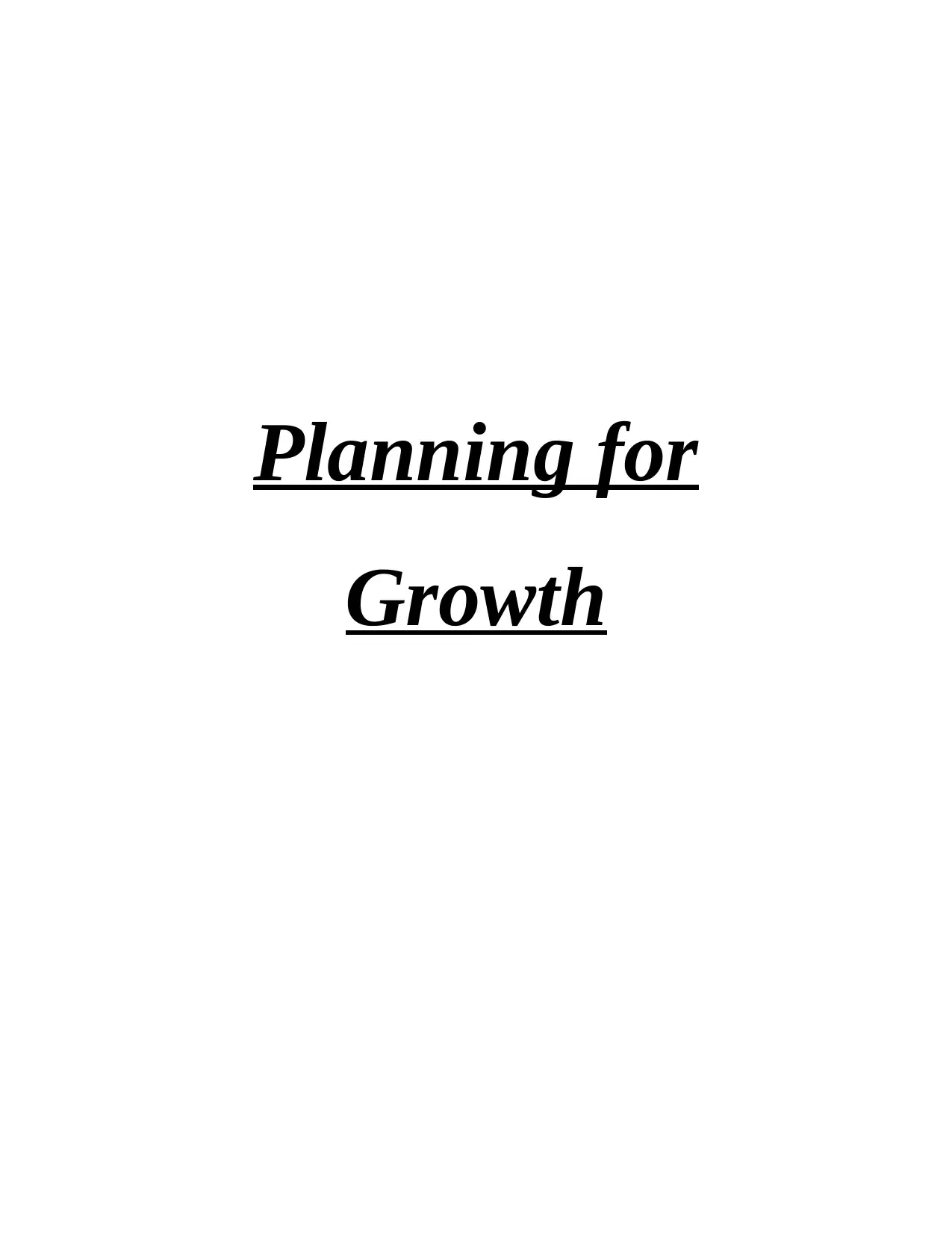
Planning for
Growth
Growth
Secure Best Marks with AI Grader
Need help grading? Try our AI Grader for instant feedback on your assignments.
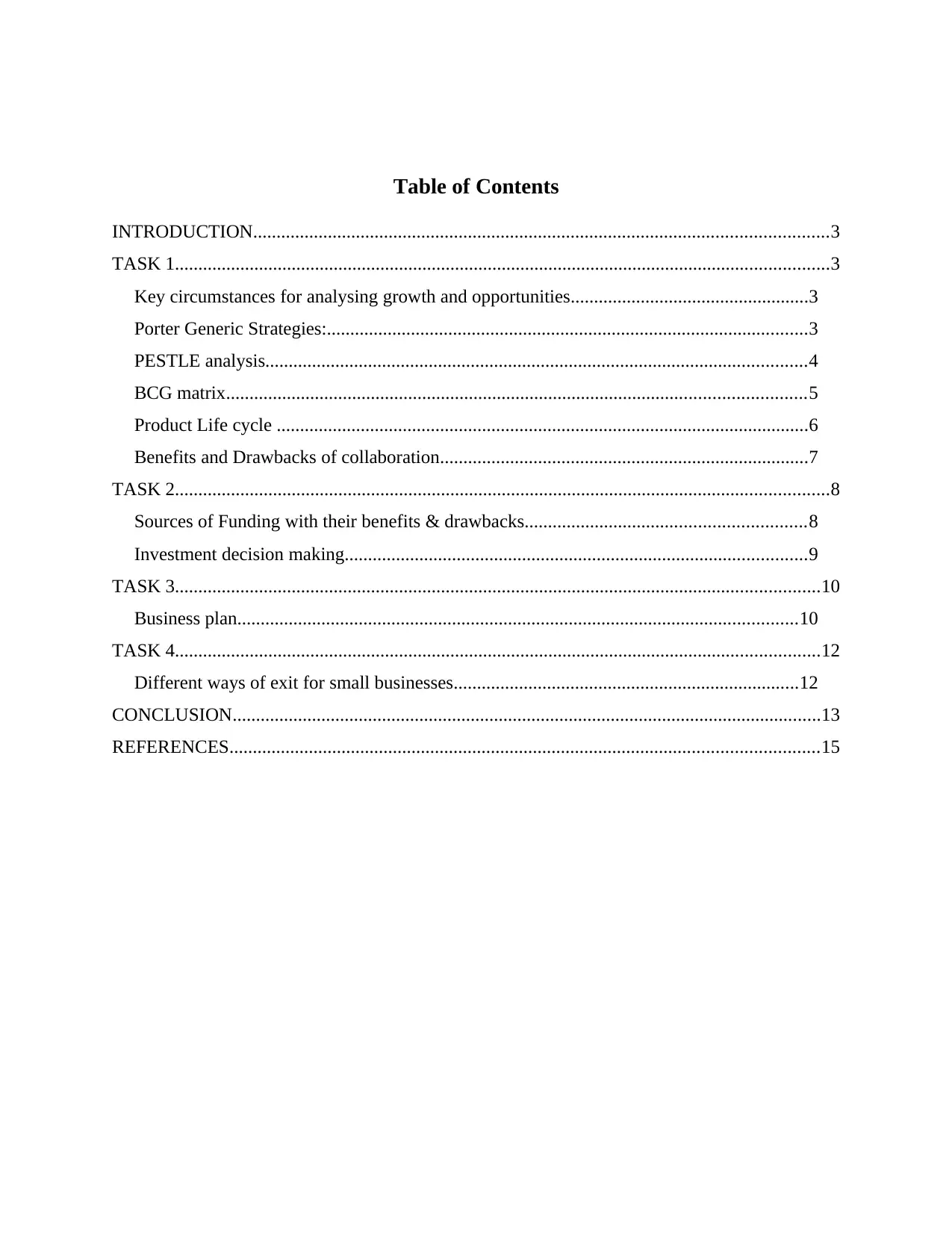
Table of Contents
INTRODUCTION...........................................................................................................................3
TASK 1............................................................................................................................................3
Key circumstances for analysing growth and opportunities...................................................3
Porter Generic Strategies:.......................................................................................................3
PESTLE analysis....................................................................................................................4
BCG matrix............................................................................................................................5
Product Life cycle ..................................................................................................................6
Benefits and Drawbacks of collaboration...............................................................................7
TASK 2............................................................................................................................................8
Sources of Funding with their benefits & drawbacks............................................................8
Investment decision making...................................................................................................9
TASK 3..........................................................................................................................................10
Business plan........................................................................................................................10
TASK 4..........................................................................................................................................12
Different ways of exit for small businesses..........................................................................12
CONCLUSION..............................................................................................................................13
REFERENCES..............................................................................................................................15
INTRODUCTION...........................................................................................................................3
TASK 1............................................................................................................................................3
Key circumstances for analysing growth and opportunities...................................................3
Porter Generic Strategies:.......................................................................................................3
PESTLE analysis....................................................................................................................4
BCG matrix............................................................................................................................5
Product Life cycle ..................................................................................................................6
Benefits and Drawbacks of collaboration...............................................................................7
TASK 2............................................................................................................................................8
Sources of Funding with their benefits & drawbacks............................................................8
Investment decision making...................................................................................................9
TASK 3..........................................................................................................................................10
Business plan........................................................................................................................10
TASK 4..........................................................................................................................................12
Different ways of exit for small businesses..........................................................................12
CONCLUSION..............................................................................................................................13
REFERENCES..............................................................................................................................15
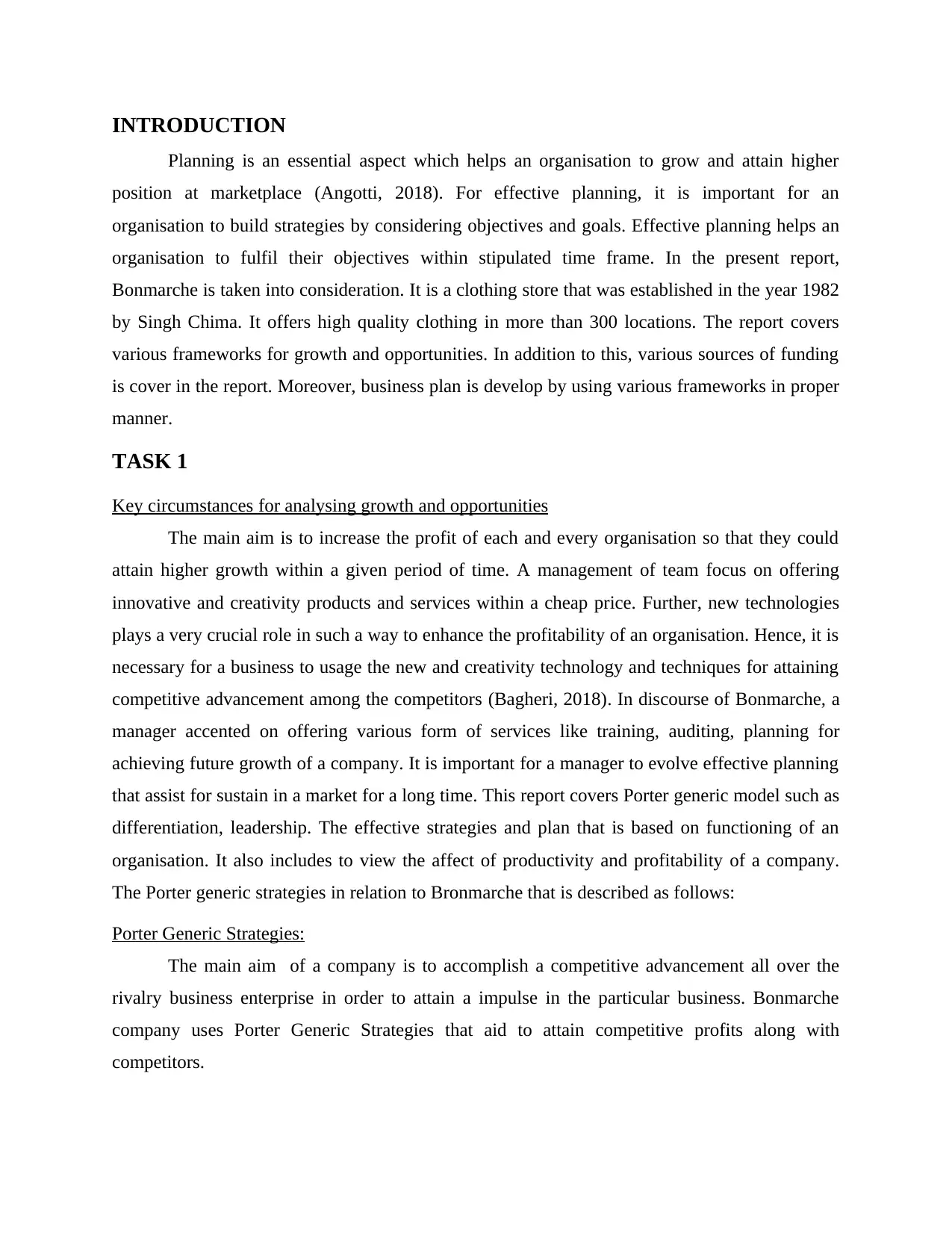
INTRODUCTION
Planning is an essential aspect which helps an organisation to grow and attain higher
position at marketplace (Angotti, 2018). For effective planning, it is important for an
organisation to build strategies by considering objectives and goals. Effective planning helps an
organisation to fulfil their objectives within stipulated time frame. In the present report,
Bonmarche is taken into consideration. It is a clothing store that was established in the year 1982
by Singh Chima. It offers high quality clothing in more than 300 locations. The report covers
various frameworks for growth and opportunities. In addition to this, various sources of funding
is cover in the report. Moreover, business plan is develop by using various frameworks in proper
manner.
TASK 1
Key circumstances for analysing growth and opportunities
The main aim is to increase the profit of each and every organisation so that they could
attain higher growth within a given period of time. A management of team focus on offering
innovative and creativity products and services within a cheap price. Further, new technologies
plays a very crucial role in such a way to enhance the profitability of an organisation. Hence, it is
necessary for a business to usage the new and creativity technology and techniques for attaining
competitive advancement among the competitors (Bagheri, 2018). In discourse of Bonmarche, a
manager accented on offering various form of services like training, auditing, planning for
achieving future growth of a company. It is important for a manager to evolve effective planning
that assist for sustain in a market for a long time. This report covers Porter generic model such as
differentiation, leadership. The effective strategies and plan that is based on functioning of an
organisation. It also includes to view the affect of productivity and profitability of a company.
The Porter generic strategies in relation to Bronmarche that is described as follows:
Porter Generic Strategies:
The main aim of a company is to accomplish a competitive advancement all over the
rivalry business enterprise in order to attain a impulse in the particular business. Bonmarche
company uses Porter Generic Strategies that aid to attain competitive profits along with
competitors.
Planning is an essential aspect which helps an organisation to grow and attain higher
position at marketplace (Angotti, 2018). For effective planning, it is important for an
organisation to build strategies by considering objectives and goals. Effective planning helps an
organisation to fulfil their objectives within stipulated time frame. In the present report,
Bonmarche is taken into consideration. It is a clothing store that was established in the year 1982
by Singh Chima. It offers high quality clothing in more than 300 locations. The report covers
various frameworks for growth and opportunities. In addition to this, various sources of funding
is cover in the report. Moreover, business plan is develop by using various frameworks in proper
manner.
TASK 1
Key circumstances for analysing growth and opportunities
The main aim is to increase the profit of each and every organisation so that they could
attain higher growth within a given period of time. A management of team focus on offering
innovative and creativity products and services within a cheap price. Further, new technologies
plays a very crucial role in such a way to enhance the profitability of an organisation. Hence, it is
necessary for a business to usage the new and creativity technology and techniques for attaining
competitive advancement among the competitors (Bagheri, 2018). In discourse of Bonmarche, a
manager accented on offering various form of services like training, auditing, planning for
achieving future growth of a company. It is important for a manager to evolve effective planning
that assist for sustain in a market for a long time. This report covers Porter generic model such as
differentiation, leadership. The effective strategies and plan that is based on functioning of an
organisation. It also includes to view the affect of productivity and profitability of a company.
The Porter generic strategies in relation to Bronmarche that is described as follows:
Porter Generic Strategies:
The main aim of a company is to accomplish a competitive advancement all over the
rivalry business enterprise in order to attain a impulse in the particular business. Bonmarche
company uses Porter Generic Strategies that aid to attain competitive profits along with
competitors.
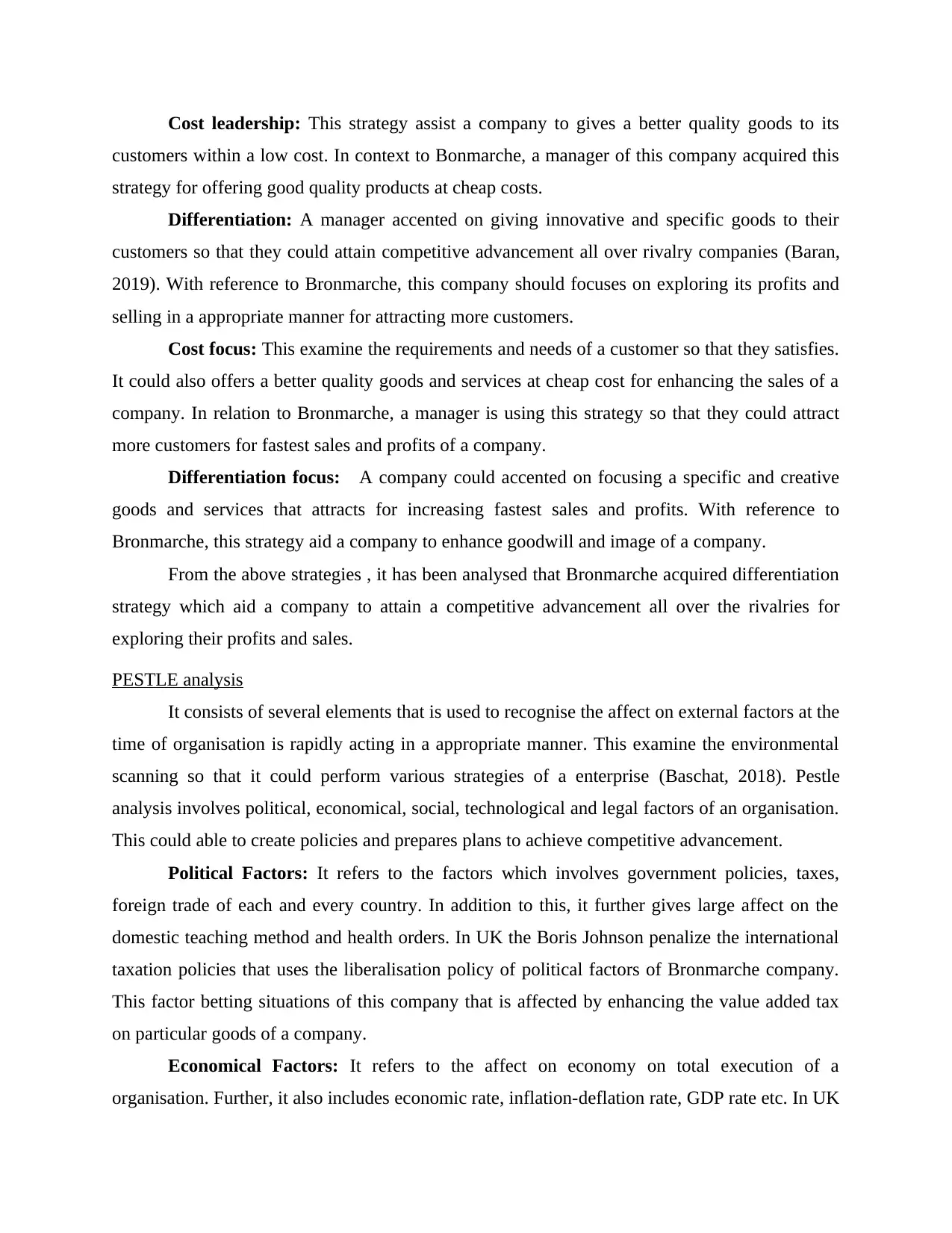
Cost leadership: This strategy assist a company to gives a better quality goods to its
customers within a low cost. In context to Bonmarche, a manager of this company acquired this
strategy for offering good quality products at cheap costs.
Differentiation: A manager accented on giving innovative and specific goods to their
customers so that they could attain competitive advancement all over rivalry companies (Baran,
2019). With reference to Bronmarche, this company should focuses on exploring its profits and
selling in a appropriate manner for attracting more customers.
Cost focus: This examine the requirements and needs of a customer so that they satisfies.
It could also offers a better quality goods and services at cheap cost for enhancing the sales of a
company. In relation to Bronmarche, a manager is using this strategy so that they could attract
more customers for fastest sales and profits of a company.
Differentiation focus: A company could accented on focusing a specific and creative
goods and services that attracts for increasing fastest sales and profits. With reference to
Bronmarche, this strategy aid a company to enhance goodwill and image of a company.
From the above strategies , it has been analysed that Bronmarche acquired differentiation
strategy which aid a company to attain a competitive advancement all over the rivalries for
exploring their profits and sales.
PESTLE analysis
It consists of several elements that is used to recognise the affect on external factors at the
time of organisation is rapidly acting in a appropriate manner. This examine the environmental
scanning so that it could perform various strategies of a enterprise (Baschat, 2018). Pestle
analysis involves political, economical, social, technological and legal factors of an organisation.
This could able to create policies and prepares plans to achieve competitive advancement.
Political Factors: It refers to the factors which involves government policies, taxes,
foreign trade of each and every country. In addition to this, it further gives large affect on the
domestic teaching method and health orders. In UK the Boris Johnson penalize the international
taxation policies that uses the liberalisation policy of political factors of Bronmarche company.
This factor betting situations of this company that is affected by enhancing the value added tax
on particular goods of a company.
Economical Factors: It refers to the affect on economy on total execution of a
organisation. Further, it also includes economic rate, inflation-deflation rate, GDP rate etc. In UK
customers within a low cost. In context to Bonmarche, a manager of this company acquired this
strategy for offering good quality products at cheap costs.
Differentiation: A manager accented on giving innovative and specific goods to their
customers so that they could attain competitive advancement all over rivalry companies (Baran,
2019). With reference to Bronmarche, this company should focuses on exploring its profits and
selling in a appropriate manner for attracting more customers.
Cost focus: This examine the requirements and needs of a customer so that they satisfies.
It could also offers a better quality goods and services at cheap cost for enhancing the sales of a
company. In relation to Bronmarche, a manager is using this strategy so that they could attract
more customers for fastest sales and profits of a company.
Differentiation focus: A company could accented on focusing a specific and creative
goods and services that attracts for increasing fastest sales and profits. With reference to
Bronmarche, this strategy aid a company to enhance goodwill and image of a company.
From the above strategies , it has been analysed that Bronmarche acquired differentiation
strategy which aid a company to attain a competitive advancement all over the rivalries for
exploring their profits and sales.
PESTLE analysis
It consists of several elements that is used to recognise the affect on external factors at the
time of organisation is rapidly acting in a appropriate manner. This examine the environmental
scanning so that it could perform various strategies of a enterprise (Baschat, 2018). Pestle
analysis involves political, economical, social, technological and legal factors of an organisation.
This could able to create policies and prepares plans to achieve competitive advancement.
Political Factors: It refers to the factors which involves government policies, taxes,
foreign trade of each and every country. In addition to this, it further gives large affect on the
domestic teaching method and health orders. In UK the Boris Johnson penalize the international
taxation policies that uses the liberalisation policy of political factors of Bronmarche company.
This factor betting situations of this company that is affected by enhancing the value added tax
on particular goods of a company.
Economical Factors: It refers to the affect on economy on total execution of a
organisation. Further, it also includes economic rate, inflation-deflation rate, GDP rate etc. In UK
Secure Best Marks with AI Grader
Need help grading? Try our AI Grader for instant feedback on your assignments.
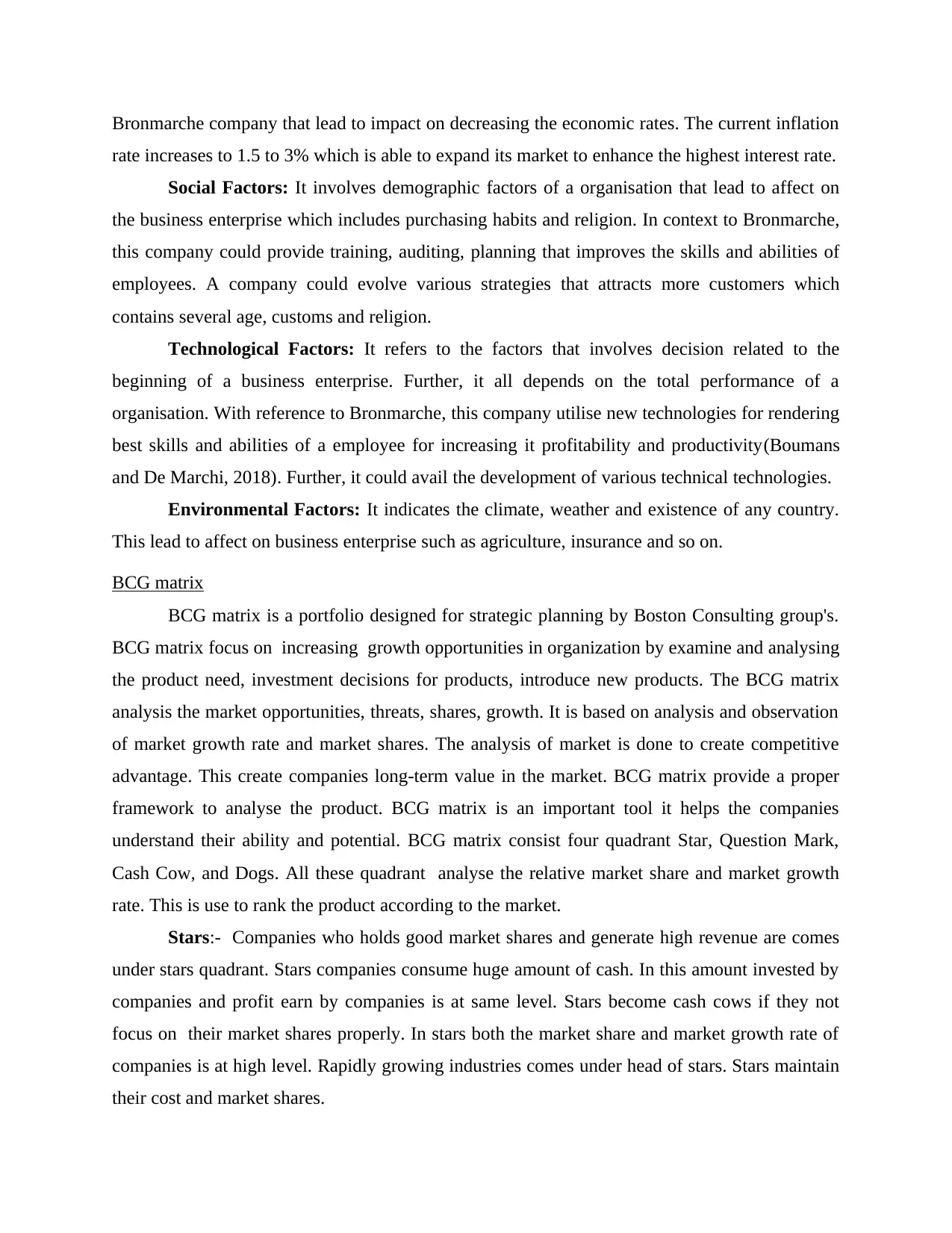
Bronmarche company that lead to impact on decreasing the economic rates. The current inflation
rate increases to 1.5 to 3% which is able to expand its market to enhance the highest interest rate.
Social Factors: It involves demographic factors of a organisation that lead to affect on
the business enterprise which includes purchasing habits and religion. In context to Bronmarche,
this company could provide training, auditing, planning that improves the skills and abilities of
employees. A company could evolve various strategies that attracts more customers which
contains several age, customs and religion.
Technological Factors: It refers to the factors that involves decision related to the
beginning of a business enterprise. Further, it all depends on the total performance of a
organisation. With reference to Bronmarche, this company utilise new technologies for rendering
best skills and abilities of a employee for increasing it profitability and productivity(Boumans
and De Marchi, 2018). Further, it could avail the development of various technical technologies.
Environmental Factors: It indicates the climate, weather and existence of any country.
This lead to affect on business enterprise such as agriculture, insurance and so on.
BCG matrix
BCG matrix is a portfolio designed for strategic planning by Boston Consulting group's.
BCG matrix focus on increasing growth opportunities in organization by examine and analysing
the product need, investment decisions for products, introduce new products. The BCG matrix
analysis the market opportunities, threats, shares, growth. It is based on analysis and observation
of market growth rate and market shares. The analysis of market is done to create competitive
advantage. This create companies long-term value in the market. BCG matrix provide a proper
framework to analyse the product. BCG matrix is an important tool it helps the companies
understand their ability and potential. BCG matrix consist four quadrant Star, Question Mark,
Cash Cow, and Dogs. All these quadrant analyse the relative market share and market growth
rate. This is use to rank the product according to the market.
Stars:- Companies who holds good market shares and generate high revenue are comes
under stars quadrant. Stars companies consume huge amount of cash. In this amount invested by
companies and profit earn by companies is at same level. Stars become cash cows if they not
focus on their market shares properly. In stars both the market share and market growth rate of
companies is at high level. Rapidly growing industries comes under head of stars. Stars maintain
their cost and market shares.
rate increases to 1.5 to 3% which is able to expand its market to enhance the highest interest rate.
Social Factors: It involves demographic factors of a organisation that lead to affect on
the business enterprise which includes purchasing habits and religion. In context to Bronmarche,
this company could provide training, auditing, planning that improves the skills and abilities of
employees. A company could evolve various strategies that attracts more customers which
contains several age, customs and religion.
Technological Factors: It refers to the factors that involves decision related to the
beginning of a business enterprise. Further, it all depends on the total performance of a
organisation. With reference to Bronmarche, this company utilise new technologies for rendering
best skills and abilities of a employee for increasing it profitability and productivity(Boumans
and De Marchi, 2018). Further, it could avail the development of various technical technologies.
Environmental Factors: It indicates the climate, weather and existence of any country.
This lead to affect on business enterprise such as agriculture, insurance and so on.
BCG matrix
BCG matrix is a portfolio designed for strategic planning by Boston Consulting group's.
BCG matrix focus on increasing growth opportunities in organization by examine and analysing
the product need, investment decisions for products, introduce new products. The BCG matrix
analysis the market opportunities, threats, shares, growth. It is based on analysis and observation
of market growth rate and market shares. The analysis of market is done to create competitive
advantage. This create companies long-term value in the market. BCG matrix provide a proper
framework to analyse the product. BCG matrix is an important tool it helps the companies
understand their ability and potential. BCG matrix consist four quadrant Star, Question Mark,
Cash Cow, and Dogs. All these quadrant analyse the relative market share and market growth
rate. This is use to rank the product according to the market.
Stars:- Companies who holds good market shares and generate high revenue are comes
under stars quadrant. Stars companies consume huge amount of cash. In this amount invested by
companies and profit earn by companies is at same level. Stars become cash cows if they not
focus on their market shares properly. In stars both the market share and market growth rate of
companies is at high level. Rapidly growing industries comes under head of stars. Stars maintain
their cost and market shares.
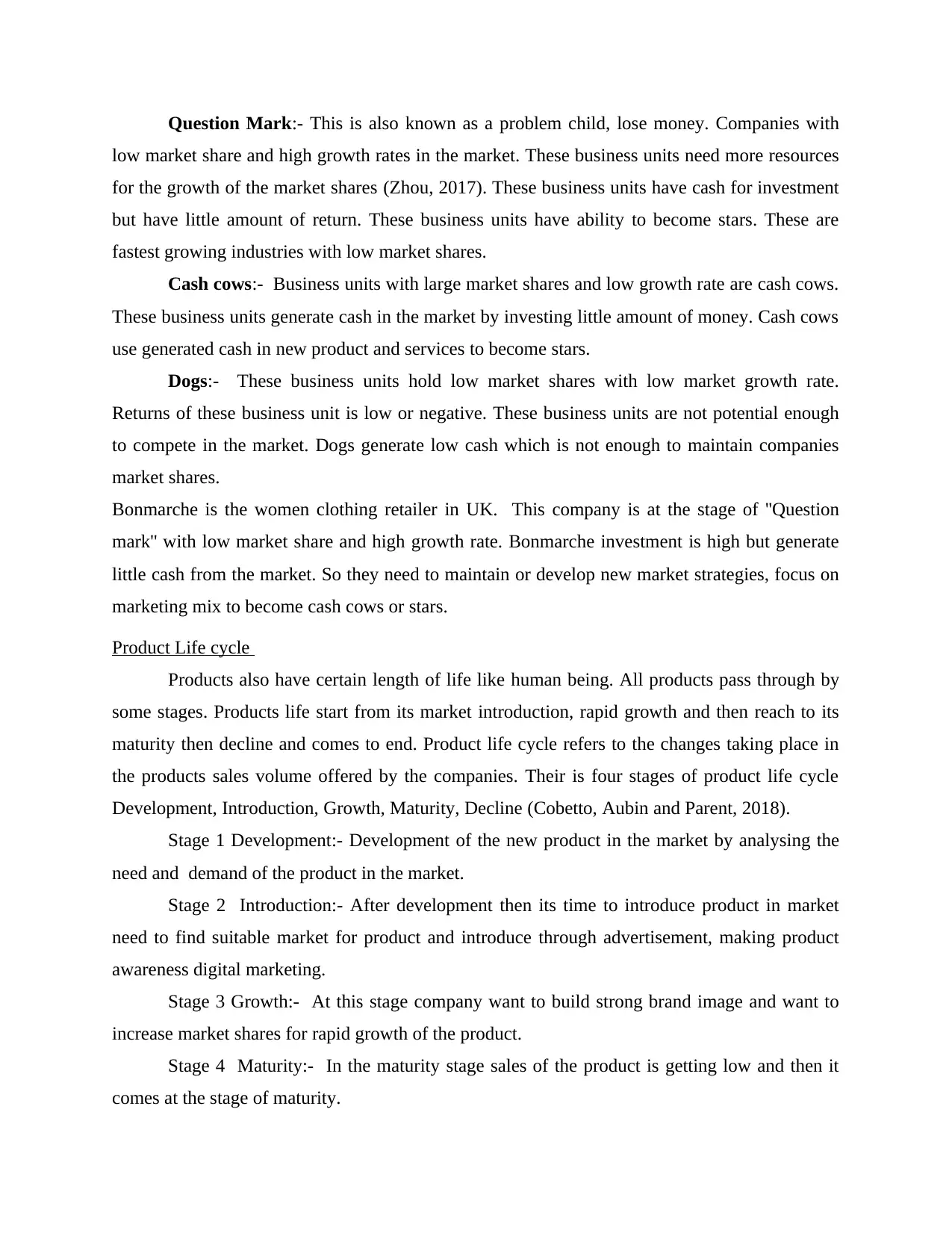
Question Mark:- This is also known as a problem child, lose money. Companies with
low market share and high growth rates in the market. These business units need more resources
for the growth of the market shares (Zhou, 2017). These business units have cash for investment
but have little amount of return. These business units have ability to become stars. These are
fastest growing industries with low market shares.
Cash cows:- Business units with large market shares and low growth rate are cash cows.
These business units generate cash in the market by investing little amount of money. Cash cows
use generated cash in new product and services to become stars.
Dogs:- These business units hold low market shares with low market growth rate.
Returns of these business unit is low or negative. These business units are not potential enough
to compete in the market. Dogs generate low cash which is not enough to maintain companies
market shares.
Bonmarche is the women clothing retailer in UK. This company is at the stage of ''Question
mark'' with low market share and high growth rate. Bonmarche investment is high but generate
little cash from the market. So they need to maintain or develop new market strategies, focus on
marketing mix to become cash cows or stars.
Product Life cycle
Products also have certain length of life like human being. All products pass through by
some stages. Products life start from its market introduction, rapid growth and then reach to its
maturity then decline and comes to end. Product life cycle refers to the changes taking place in
the products sales volume offered by the companies. Their is four stages of product life cycle
Development, Introduction, Growth, Maturity, Decline (Cobetto, Aubin and Parent, 2018).
Stage 1 Development:- Development of the new product in the market by analysing the
need and demand of the product in the market.
Stage 2 Introduction:- After development then its time to introduce product in market
need to find suitable market for product and introduce through advertisement, making product
awareness digital marketing.
Stage 3 Growth:- At this stage company want to build strong brand image and want to
increase market shares for rapid growth of the product.
Stage 4 Maturity:- In the maturity stage sales of the product is getting low and then it
comes at the stage of maturity.
low market share and high growth rates in the market. These business units need more resources
for the growth of the market shares (Zhou, 2017). These business units have cash for investment
but have little amount of return. These business units have ability to become stars. These are
fastest growing industries with low market shares.
Cash cows:- Business units with large market shares and low growth rate are cash cows.
These business units generate cash in the market by investing little amount of money. Cash cows
use generated cash in new product and services to become stars.
Dogs:- These business units hold low market shares with low market growth rate.
Returns of these business unit is low or negative. These business units are not potential enough
to compete in the market. Dogs generate low cash which is not enough to maintain companies
market shares.
Bonmarche is the women clothing retailer in UK. This company is at the stage of ''Question
mark'' with low market share and high growth rate. Bonmarche investment is high but generate
little cash from the market. So they need to maintain or develop new market strategies, focus on
marketing mix to become cash cows or stars.
Product Life cycle
Products also have certain length of life like human being. All products pass through by
some stages. Products life start from its market introduction, rapid growth and then reach to its
maturity then decline and comes to end. Product life cycle refers to the changes taking place in
the products sales volume offered by the companies. Their is four stages of product life cycle
Development, Introduction, Growth, Maturity, Decline (Cobetto, Aubin and Parent, 2018).
Stage 1 Development:- Development of the new product in the market by analysing the
need and demand of the product in the market.
Stage 2 Introduction:- After development then its time to introduce product in market
need to find suitable market for product and introduce through advertisement, making product
awareness digital marketing.
Stage 3 Growth:- At this stage company want to build strong brand image and want to
increase market shares for rapid growth of the product.
Stage 4 Maturity:- In the maturity stage sales of the product is getting low and then it
comes at the stage of maturity.
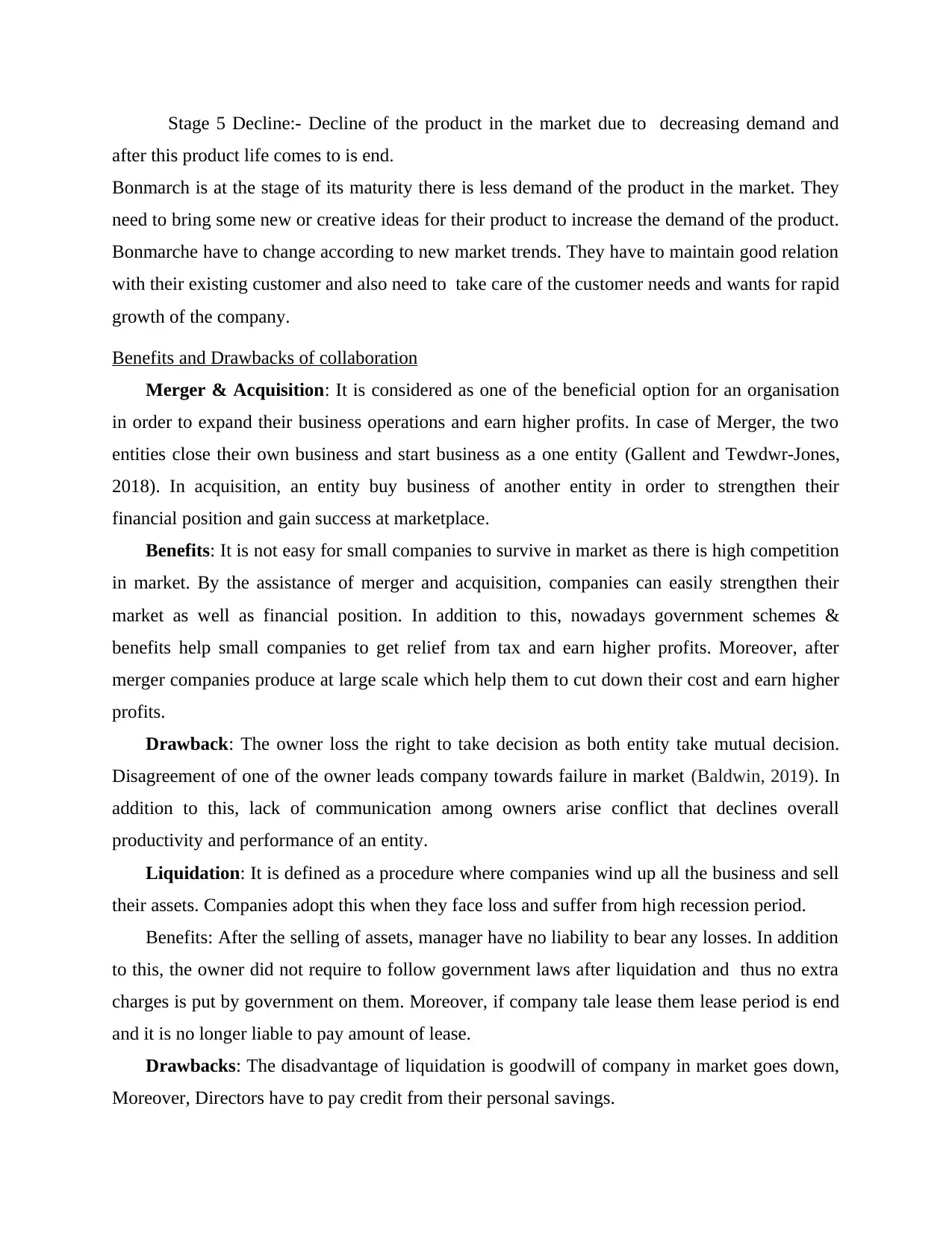
Stage 5 Decline:- Decline of the product in the market due to decreasing demand and
after this product life comes to is end.
Bonmarch is at the stage of its maturity there is less demand of the product in the market. They
need to bring some new or creative ideas for their product to increase the demand of the product.
Bonmarche have to change according to new market trends. They have to maintain good relation
with their existing customer and also need to take care of the customer needs and wants for rapid
growth of the company.
Benefits and Drawbacks of collaboration
Merger & Acquisition: It is considered as one of the beneficial option for an organisation
in order to expand their business operations and earn higher profits. In case of Merger, the two
entities close their own business and start business as a one entity (Gallent and Tewdwr-Jones,
2018). In acquisition, an entity buy business of another entity in order to strengthen their
financial position and gain success at marketplace.
Benefits: It is not easy for small companies to survive in market as there is high competition
in market. By the assistance of merger and acquisition, companies can easily strengthen their
market as well as financial position. In addition to this, nowadays government schemes &
benefits help small companies to get relief from tax and earn higher profits. Moreover, after
merger companies produce at large scale which help them to cut down their cost and earn higher
profits.
Drawback: The owner loss the right to take decision as both entity take mutual decision.
Disagreement of one of the owner leads company towards failure in market (Baldwin, 2019). In
addition to this, lack of communication among owners arise conflict that declines overall
productivity and performance of an entity.
Liquidation: It is defined as a procedure where companies wind up all the business and sell
their assets. Companies adopt this when they face loss and suffer from high recession period.
Benefits: After the selling of assets, manager have no liability to bear any losses. In addition
to this, the owner did not require to follow government laws after liquidation and thus no extra
charges is put by government on them. Moreover, if company tale lease them lease period is end
and it is no longer liable to pay amount of lease.
Drawbacks: The disadvantage of liquidation is goodwill of company in market goes down,
Moreover, Directors have to pay credit from their personal savings.
after this product life comes to is end.
Bonmarch is at the stage of its maturity there is less demand of the product in the market. They
need to bring some new or creative ideas for their product to increase the demand of the product.
Bonmarche have to change according to new market trends. They have to maintain good relation
with their existing customer and also need to take care of the customer needs and wants for rapid
growth of the company.
Benefits and Drawbacks of collaboration
Merger & Acquisition: It is considered as one of the beneficial option for an organisation
in order to expand their business operations and earn higher profits. In case of Merger, the two
entities close their own business and start business as a one entity (Gallent and Tewdwr-Jones,
2018). In acquisition, an entity buy business of another entity in order to strengthen their
financial position and gain success at marketplace.
Benefits: It is not easy for small companies to survive in market as there is high competition
in market. By the assistance of merger and acquisition, companies can easily strengthen their
market as well as financial position. In addition to this, nowadays government schemes &
benefits help small companies to get relief from tax and earn higher profits. Moreover, after
merger companies produce at large scale which help them to cut down their cost and earn higher
profits.
Drawback: The owner loss the right to take decision as both entity take mutual decision.
Disagreement of one of the owner leads company towards failure in market (Baldwin, 2019). In
addition to this, lack of communication among owners arise conflict that declines overall
productivity and performance of an entity.
Liquidation: It is defined as a procedure where companies wind up all the business and sell
their assets. Companies adopt this when they face loss and suffer from high recession period.
Benefits: After the selling of assets, manager have no liability to bear any losses. In addition
to this, the owner did not require to follow government laws after liquidation and thus no extra
charges is put by government on them. Moreover, if company tale lease them lease period is end
and it is no longer liable to pay amount of lease.
Drawbacks: The disadvantage of liquidation is goodwill of company in market goes down,
Moreover, Directors have to pay credit from their personal savings.
Paraphrase This Document
Need a fresh take? Get an instant paraphrase of this document with our AI Paraphraser
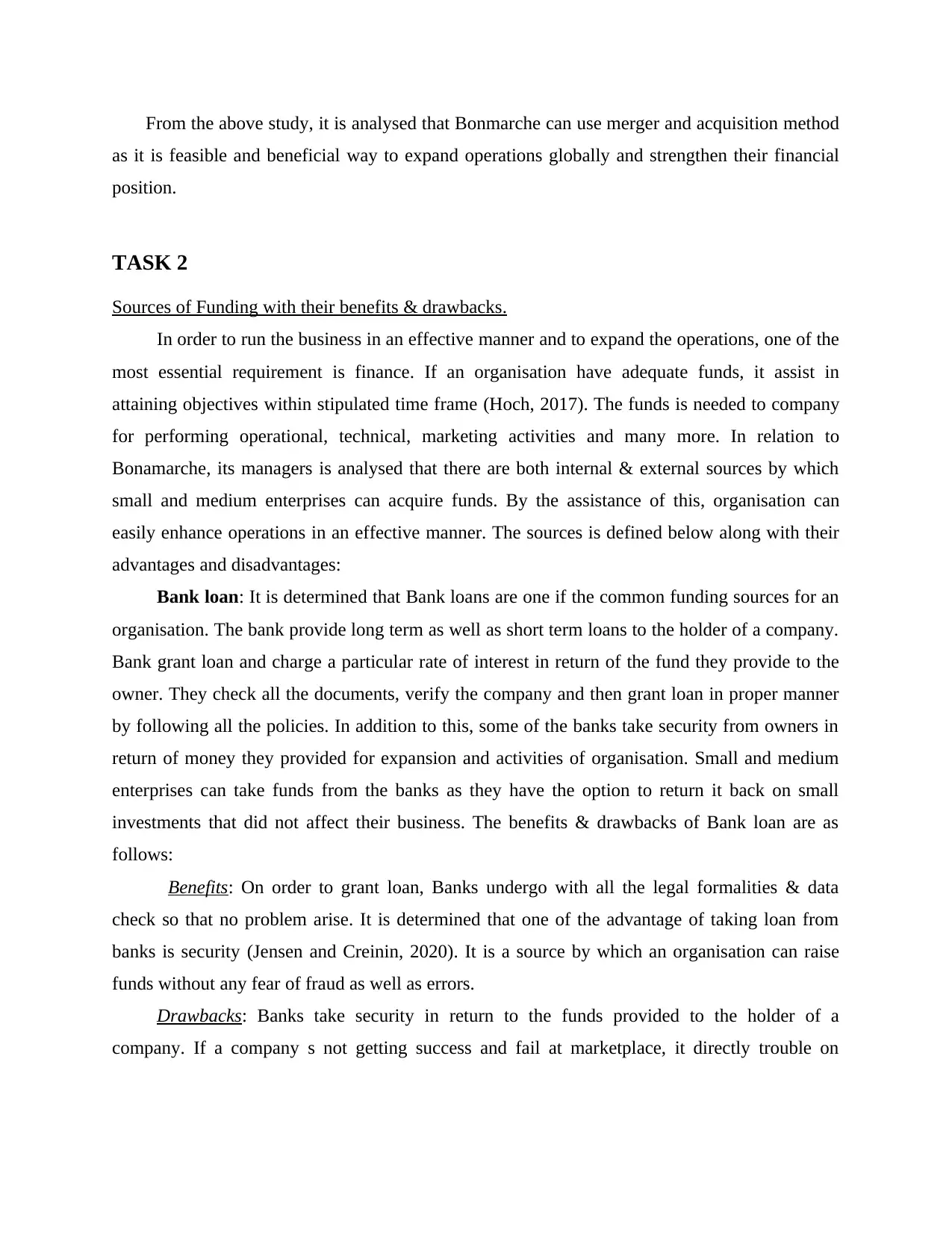
From the above study, it is analysed that Bonmarche can use merger and acquisition method
as it is feasible and beneficial way to expand operations globally and strengthen their financial
position.
TASK 2
Sources of Funding with their benefits & drawbacks.
In order to run the business in an effective manner and to expand the operations, one of the
most essential requirement is finance. If an organisation have adequate funds, it assist in
attaining objectives within stipulated time frame (Hoch, 2017). The funds is needed to company
for performing operational, technical, marketing activities and many more. In relation to
Bonamarche, its managers is analysed that there are both internal & external sources by which
small and medium enterprises can acquire funds. By the assistance of this, organisation can
easily enhance operations in an effective manner. The sources is defined below along with their
advantages and disadvantages:
Bank loan: It is determined that Bank loans are one if the common funding sources for an
organisation. The bank provide long term as well as short term loans to the holder of a company.
Bank grant loan and charge a particular rate of interest in return of the fund they provide to the
owner. They check all the documents, verify the company and then grant loan in proper manner
by following all the policies. In addition to this, some of the banks take security from owners in
return of money they provided for expansion and activities of organisation. Small and medium
enterprises can take funds from the banks as they have the option to return it back on small
investments that did not affect their business. The benefits & drawbacks of Bank loan are as
follows:
Benefits: On order to grant loan, Banks undergo with all the legal formalities & data
check so that no problem arise. It is determined that one of the advantage of taking loan from
banks is security (Jensen and Creinin, 2020). It is a source by which an organisation can raise
funds without any fear of fraud as well as errors.
Drawbacks: Banks take security in return to the funds provided to the holder of a
company. If a company s not getting success and fail at marketplace, it directly trouble on
as it is feasible and beneficial way to expand operations globally and strengthen their financial
position.
TASK 2
Sources of Funding with their benefits & drawbacks.
In order to run the business in an effective manner and to expand the operations, one of the
most essential requirement is finance. If an organisation have adequate funds, it assist in
attaining objectives within stipulated time frame (Hoch, 2017). The funds is needed to company
for performing operational, technical, marketing activities and many more. In relation to
Bonamarche, its managers is analysed that there are both internal & external sources by which
small and medium enterprises can acquire funds. By the assistance of this, organisation can
easily enhance operations in an effective manner. The sources is defined below along with their
advantages and disadvantages:
Bank loan: It is determined that Bank loans are one if the common funding sources for an
organisation. The bank provide long term as well as short term loans to the holder of a company.
Bank grant loan and charge a particular rate of interest in return of the fund they provide to the
owner. They check all the documents, verify the company and then grant loan in proper manner
by following all the policies. In addition to this, some of the banks take security from owners in
return of money they provided for expansion and activities of organisation. Small and medium
enterprises can take funds from the banks as they have the option to return it back on small
investments that did not affect their business. The benefits & drawbacks of Bank loan are as
follows:
Benefits: On order to grant loan, Banks undergo with all the legal formalities & data
check so that no problem arise. It is determined that one of the advantage of taking loan from
banks is security (Jensen and Creinin, 2020). It is a source by which an organisation can raise
funds without any fear of fraud as well as errors.
Drawbacks: Banks take security in return to the funds provided to the holder of a
company. If a company s not getting success and fail at marketplace, it directly trouble on
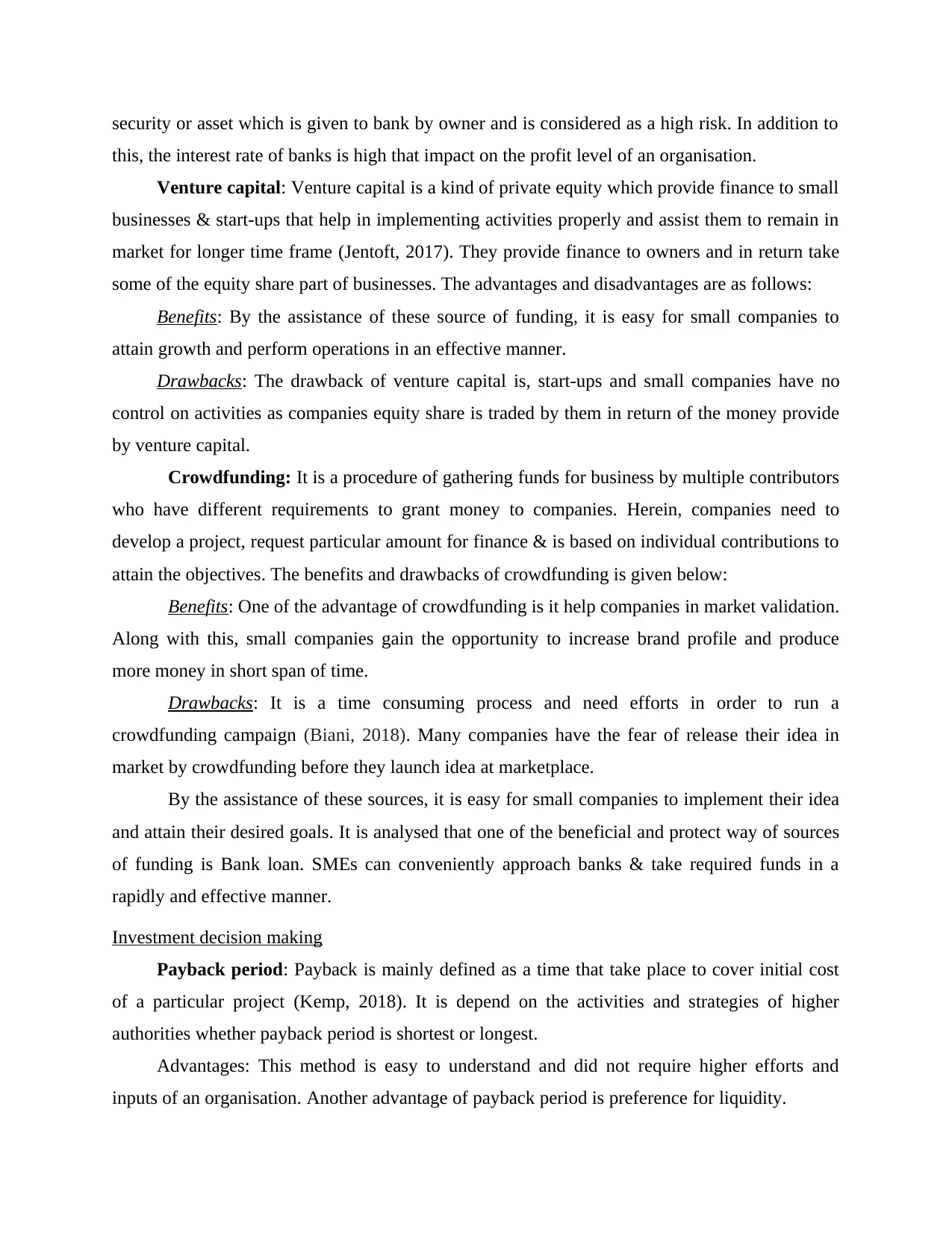
security or asset which is given to bank by owner and is considered as a high risk. In addition to
this, the interest rate of banks is high that impact on the profit level of an organisation.
Venture capital: Venture capital is a kind of private equity which provide finance to small
businesses & start-ups that help in implementing activities properly and assist them to remain in
market for longer time frame (Jentoft, 2017). They provide finance to owners and in return take
some of the equity share part of businesses. The advantages and disadvantages are as follows:
Benefits: By the assistance of these source of funding, it is easy for small companies to
attain growth and perform operations in an effective manner.
Drawbacks: The drawback of venture capital is, start-ups and small companies have no
control on activities as companies equity share is traded by them in return of the money provide
by venture capital.
Crowdfunding: It is a procedure of gathering funds for business by multiple contributors
who have different requirements to grant money to companies. Herein, companies need to
develop a project, request particular amount for finance & is based on individual contributions to
attain the objectives. The benefits and drawbacks of crowdfunding is given below:
Benefits: One of the advantage of crowdfunding is it help companies in market validation.
Along with this, small companies gain the opportunity to increase brand profile and produce
more money in short span of time.
Drawbacks: It is a time consuming process and need efforts in order to run a
crowdfunding campaign (Biani, 2018). Many companies have the fear of release their idea in
market by crowdfunding before they launch idea at marketplace.
By the assistance of these sources, it is easy for small companies to implement their idea
and attain their desired goals. It is analysed that one of the beneficial and protect way of sources
of funding is Bank loan. SMEs can conveniently approach banks & take required funds in a
rapidly and effective manner.
Investment decision making
Payback period: Payback is mainly defined as a time that take place to cover initial cost
of a particular project (Kemp, 2018). It is depend on the activities and strategies of higher
authorities whether payback period is shortest or longest.
Advantages: This method is easy to understand and did not require higher efforts and
inputs of an organisation. Another advantage of payback period is preference for liquidity.
this, the interest rate of banks is high that impact on the profit level of an organisation.
Venture capital: Venture capital is a kind of private equity which provide finance to small
businesses & start-ups that help in implementing activities properly and assist them to remain in
market for longer time frame (Jentoft, 2017). They provide finance to owners and in return take
some of the equity share part of businesses. The advantages and disadvantages are as follows:
Benefits: By the assistance of these source of funding, it is easy for small companies to
attain growth and perform operations in an effective manner.
Drawbacks: The drawback of venture capital is, start-ups and small companies have no
control on activities as companies equity share is traded by them in return of the money provide
by venture capital.
Crowdfunding: It is a procedure of gathering funds for business by multiple contributors
who have different requirements to grant money to companies. Herein, companies need to
develop a project, request particular amount for finance & is based on individual contributions to
attain the objectives. The benefits and drawbacks of crowdfunding is given below:
Benefits: One of the advantage of crowdfunding is it help companies in market validation.
Along with this, small companies gain the opportunity to increase brand profile and produce
more money in short span of time.
Drawbacks: It is a time consuming process and need efforts in order to run a
crowdfunding campaign (Biani, 2018). Many companies have the fear of release their idea in
market by crowdfunding before they launch idea at marketplace.
By the assistance of these sources, it is easy for small companies to implement their idea
and attain their desired goals. It is analysed that one of the beneficial and protect way of sources
of funding is Bank loan. SMEs can conveniently approach banks & take required funds in a
rapidly and effective manner.
Investment decision making
Payback period: Payback is mainly defined as a time that take place to cover initial cost
of a particular project (Kemp, 2018). It is depend on the activities and strategies of higher
authorities whether payback period is shortest or longest.
Advantages: This method is easy to understand and did not require higher efforts and
inputs of an organisation. Another advantage of payback period is preference for liquidity.
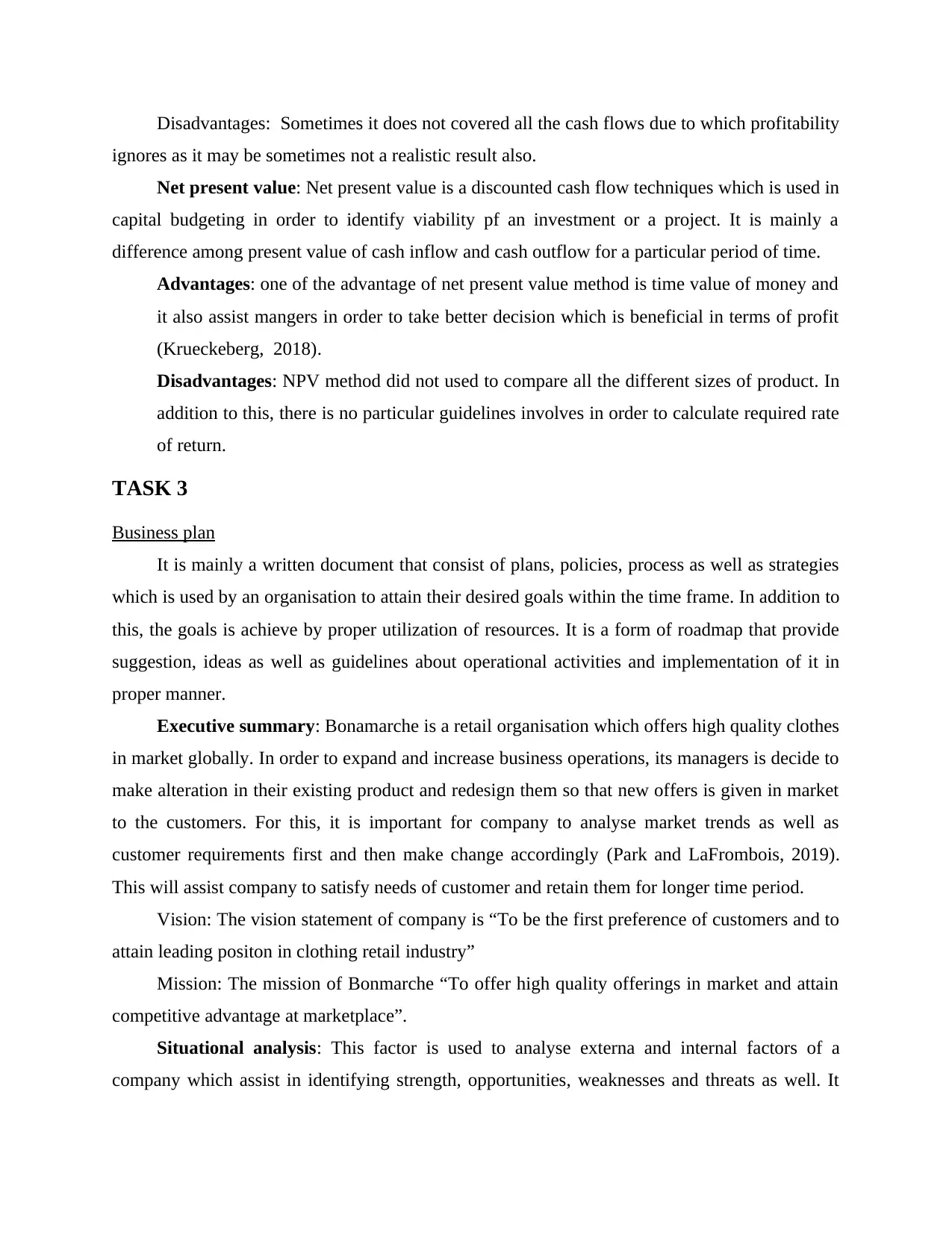
Disadvantages: Sometimes it does not covered all the cash flows due to which profitability
ignores as it may be sometimes not a realistic result also.
Net present value: Net present value is a discounted cash flow techniques which is used in
capital budgeting in order to identify viability pf an investment or a project. It is mainly a
difference among present value of cash inflow and cash outflow for a particular period of time.
Advantages: one of the advantage of net present value method is time value of money and
it also assist mangers in order to take better decision which is beneficial in terms of profit
(Krueckeberg, 2018).
Disadvantages: NPV method did not used to compare all the different sizes of product. In
addition to this, there is no particular guidelines involves in order to calculate required rate
of return.
TASK 3
Business plan
It is mainly a written document that consist of plans, policies, process as well as strategies
which is used by an organisation to attain their desired goals within the time frame. In addition to
this, the goals is achieve by proper utilization of resources. It is a form of roadmap that provide
suggestion, ideas as well as guidelines about operational activities and implementation of it in
proper manner.
Executive summary: Bonamarche is a retail organisation which offers high quality clothes
in market globally. In order to expand and increase business operations, its managers is decide to
make alteration in their existing product and redesign them so that new offers is given in market
to the customers. For this, it is important for company to analyse market trends as well as
customer requirements first and then make change accordingly (Park and LaFrombois, 2019).
This will assist company to satisfy needs of customer and retain them for longer time period.
Vision: The vision statement of company is “To be the first preference of customers and to
attain leading positon in clothing retail industry”
Mission: The mission of Bonmarche “To offer high quality offerings in market and attain
competitive advantage at marketplace”.
Situational analysis: This factor is used to analyse externa and internal factors of a
company which assist in identifying strength, opportunities, weaknesses and threats as well. It
ignores as it may be sometimes not a realistic result also.
Net present value: Net present value is a discounted cash flow techniques which is used in
capital budgeting in order to identify viability pf an investment or a project. It is mainly a
difference among present value of cash inflow and cash outflow for a particular period of time.
Advantages: one of the advantage of net present value method is time value of money and
it also assist mangers in order to take better decision which is beneficial in terms of profit
(Krueckeberg, 2018).
Disadvantages: NPV method did not used to compare all the different sizes of product. In
addition to this, there is no particular guidelines involves in order to calculate required rate
of return.
TASK 3
Business plan
It is mainly a written document that consist of plans, policies, process as well as strategies
which is used by an organisation to attain their desired goals within the time frame. In addition to
this, the goals is achieve by proper utilization of resources. It is a form of roadmap that provide
suggestion, ideas as well as guidelines about operational activities and implementation of it in
proper manner.
Executive summary: Bonamarche is a retail organisation which offers high quality clothes
in market globally. In order to expand and increase business operations, its managers is decide to
make alteration in their existing product and redesign them so that new offers is given in market
to the customers. For this, it is important for company to analyse market trends as well as
customer requirements first and then make change accordingly (Park and LaFrombois, 2019).
This will assist company to satisfy needs of customer and retain them for longer time period.
Vision: The vision statement of company is “To be the first preference of customers and to
attain leading positon in clothing retail industry”
Mission: The mission of Bonmarche “To offer high quality offerings in market and attain
competitive advantage at marketplace”.
Situational analysis: This factor is used to analyse externa and internal factors of a
company which assist in identifying strength, opportunities, weaknesses and threats as well. It
Secure Best Marks with AI Grader
Need help grading? Try our AI Grader for instant feedback on your assignments.
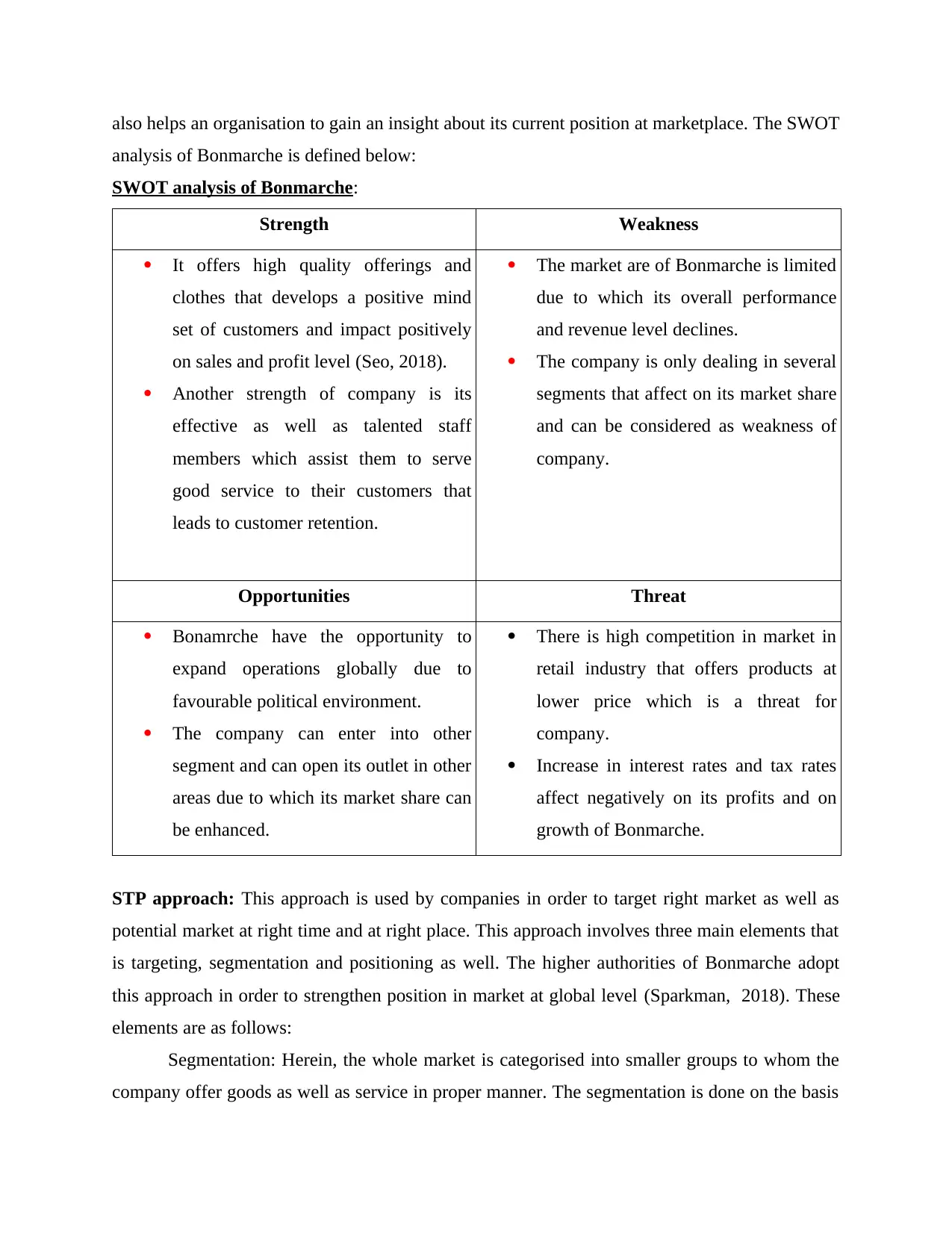
also helps an organisation to gain an insight about its current position at marketplace. The SWOT
analysis of Bonmarche is defined below:
SWOT analysis of Bonmarche:
Strength Weakness
It offers high quality offerings and
clothes that develops a positive mind
set of customers and impact positively
on sales and profit level (Seo, 2018).
Another strength of company is its
effective as well as talented staff
members which assist them to serve
good service to their customers that
leads to customer retention.
The market are of Bonmarche is limited
due to which its overall performance
and revenue level declines.
The company is only dealing in several
segments that affect on its market share
and can be considered as weakness of
company.
Opportunities Threat
Bonamrche have the opportunity to
expand operations globally due to
favourable political environment.
The company can enter into other
segment and can open its outlet in other
areas due to which its market share can
be enhanced.
There is high competition in market in
retail industry that offers products at
lower price which is a threat for
company.
Increase in interest rates and tax rates
affect negatively on its profits and on
growth of Bonmarche.
STP approach: This approach is used by companies in order to target right market as well as
potential market at right time and at right place. This approach involves three main elements that
is targeting, segmentation and positioning as well. The higher authorities of Bonmarche adopt
this approach in order to strengthen position in market at global level (Sparkman, 2018). These
elements are as follows:
Segmentation: Herein, the whole market is categorised into smaller groups to whom the
company offer goods as well as service in proper manner. The segmentation is done on the basis
analysis of Bonmarche is defined below:
SWOT analysis of Bonmarche:
Strength Weakness
It offers high quality offerings and
clothes that develops a positive mind
set of customers and impact positively
on sales and profit level (Seo, 2018).
Another strength of company is its
effective as well as talented staff
members which assist them to serve
good service to their customers that
leads to customer retention.
The market are of Bonmarche is limited
due to which its overall performance
and revenue level declines.
The company is only dealing in several
segments that affect on its market share
and can be considered as weakness of
company.
Opportunities Threat
Bonamrche have the opportunity to
expand operations globally due to
favourable political environment.
The company can enter into other
segment and can open its outlet in other
areas due to which its market share can
be enhanced.
There is high competition in market in
retail industry that offers products at
lower price which is a threat for
company.
Increase in interest rates and tax rates
affect negatively on its profits and on
growth of Bonmarche.
STP approach: This approach is used by companies in order to target right market as well as
potential market at right time and at right place. This approach involves three main elements that
is targeting, segmentation and positioning as well. The higher authorities of Bonmarche adopt
this approach in order to strengthen position in market at global level (Sparkman, 2018). These
elements are as follows:
Segmentation: Herein, the whole market is categorised into smaller groups to whom the
company offer goods as well as service in proper manner. The segmentation is done on the basis
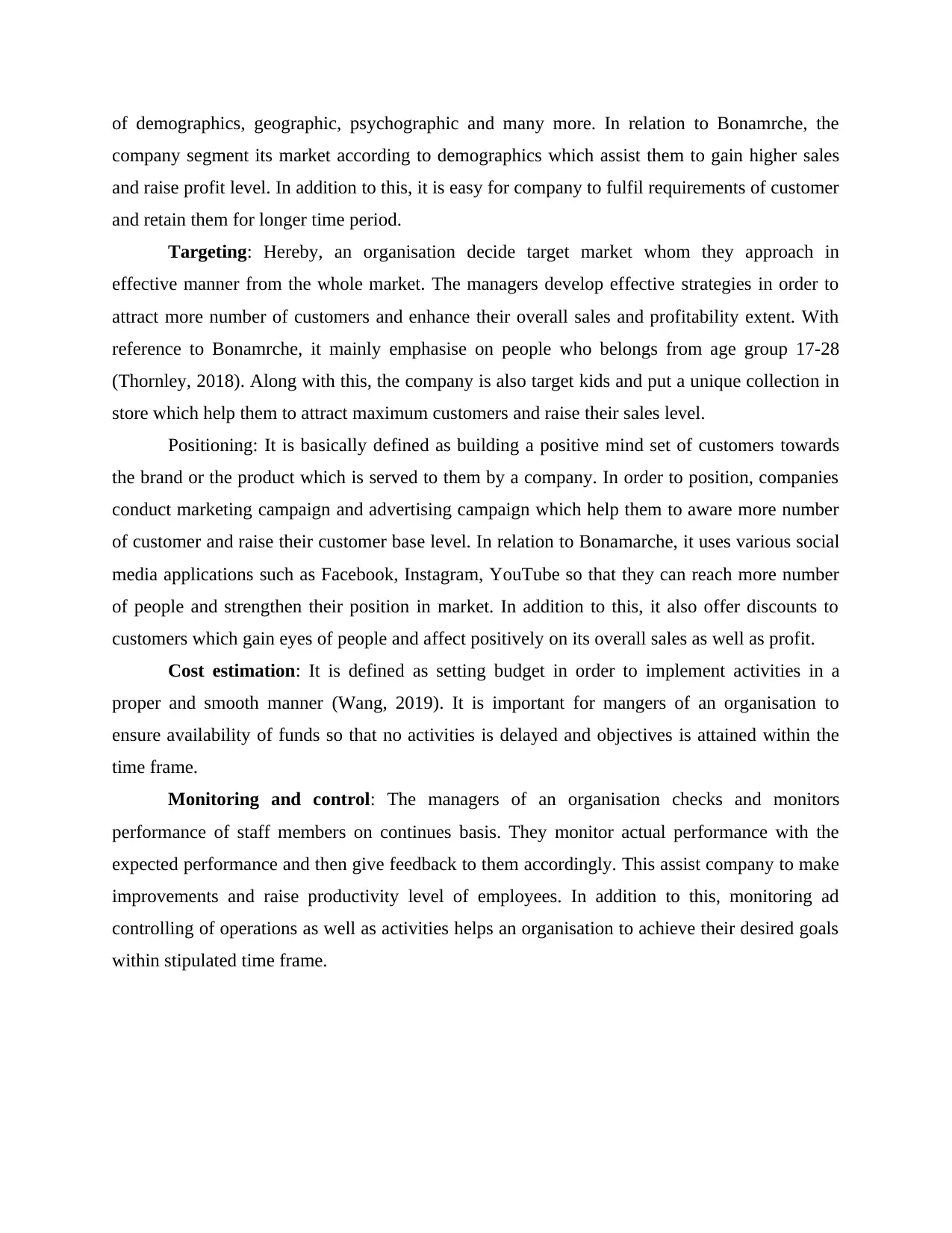
of demographics, geographic, psychographic and many more. In relation to Bonamrche, the
company segment its market according to demographics which assist them to gain higher sales
and raise profit level. In addition to this, it is easy for company to fulfil requirements of customer
and retain them for longer time period.
Targeting: Hereby, an organisation decide target market whom they approach in
effective manner from the whole market. The managers develop effective strategies in order to
attract more number of customers and enhance their overall sales and profitability extent. With
reference to Bonamrche, it mainly emphasise on people who belongs from age group 17-28
(Thornley, 2018). Along with this, the company is also target kids and put a unique collection in
store which help them to attract maximum customers and raise their sales level.
Positioning: It is basically defined as building a positive mind set of customers towards
the brand or the product which is served to them by a company. In order to position, companies
conduct marketing campaign and advertising campaign which help them to aware more number
of customer and raise their customer base level. In relation to Bonamarche, it uses various social
media applications such as Facebook, Instagram, YouTube so that they can reach more number
of people and strengthen their position in market. In addition to this, it also offer discounts to
customers which gain eyes of people and affect positively on its overall sales as well as profit.
Cost estimation: It is defined as setting budget in order to implement activities in a
proper and smooth manner (Wang, 2019). It is important for mangers of an organisation to
ensure availability of funds so that no activities is delayed and objectives is attained within the
time frame.
Monitoring and control: The managers of an organisation checks and monitors
performance of staff members on continues basis. They monitor actual performance with the
expected performance and then give feedback to them accordingly. This assist company to make
improvements and raise productivity level of employees. In addition to this, monitoring ad
controlling of operations as well as activities helps an organisation to achieve their desired goals
within stipulated time frame.
company segment its market according to demographics which assist them to gain higher sales
and raise profit level. In addition to this, it is easy for company to fulfil requirements of customer
and retain them for longer time period.
Targeting: Hereby, an organisation decide target market whom they approach in
effective manner from the whole market. The managers develop effective strategies in order to
attract more number of customers and enhance their overall sales and profitability extent. With
reference to Bonamrche, it mainly emphasise on people who belongs from age group 17-28
(Thornley, 2018). Along with this, the company is also target kids and put a unique collection in
store which help them to attract maximum customers and raise their sales level.
Positioning: It is basically defined as building a positive mind set of customers towards
the brand or the product which is served to them by a company. In order to position, companies
conduct marketing campaign and advertising campaign which help them to aware more number
of customer and raise their customer base level. In relation to Bonamarche, it uses various social
media applications such as Facebook, Instagram, YouTube so that they can reach more number
of people and strengthen their position in market. In addition to this, it also offer discounts to
customers which gain eyes of people and affect positively on its overall sales as well as profit.
Cost estimation: It is defined as setting budget in order to implement activities in a
proper and smooth manner (Wang, 2019). It is important for mangers of an organisation to
ensure availability of funds so that no activities is delayed and objectives is attained within the
time frame.
Monitoring and control: The managers of an organisation checks and monitors
performance of staff members on continues basis. They monitor actual performance with the
expected performance and then give feedback to them accordingly. This assist company to make
improvements and raise productivity level of employees. In addition to this, monitoring ad
controlling of operations as well as activities helps an organisation to achieve their desired goals
within stipulated time frame.
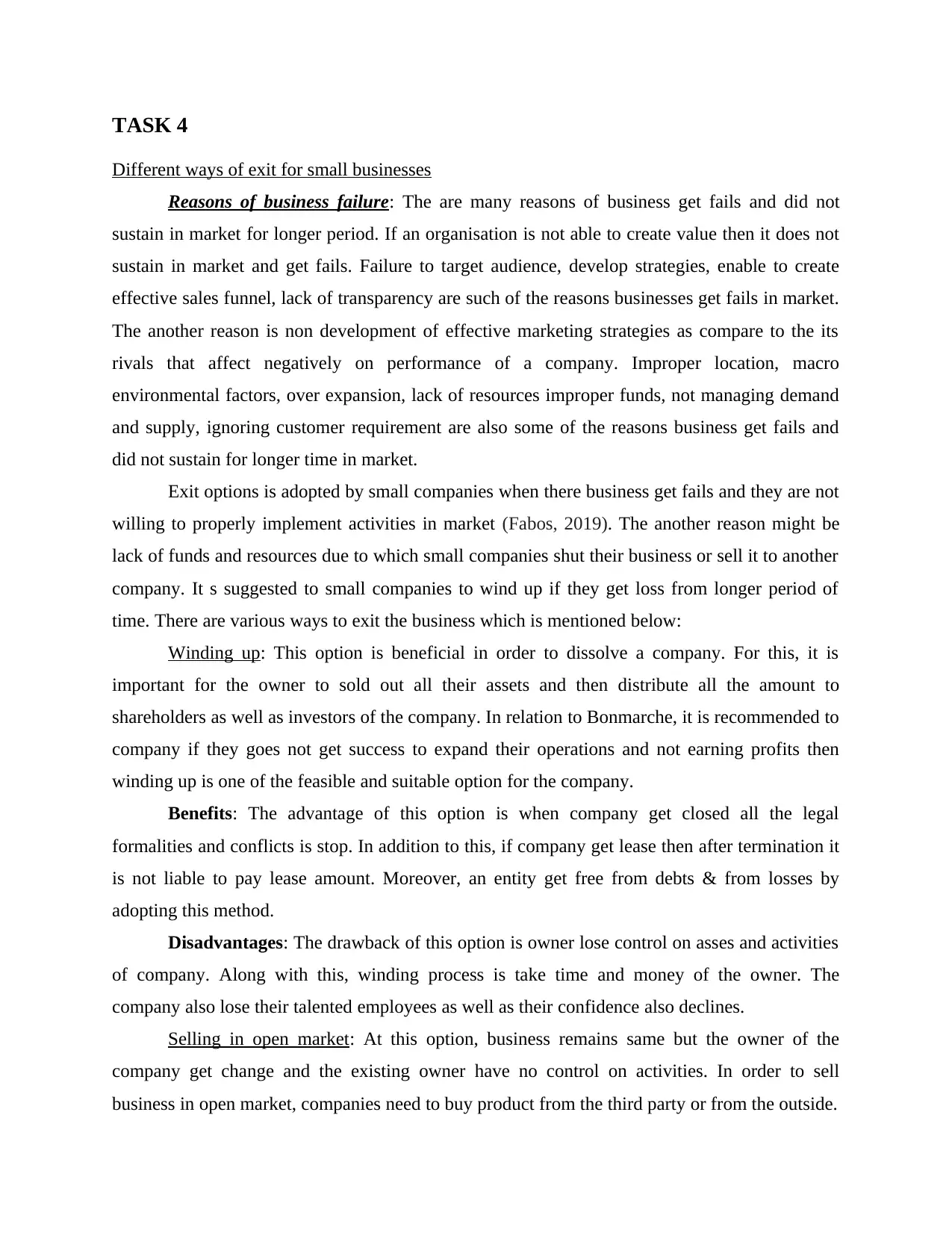
TASK 4
Different ways of exit for small businesses
Reasons of business failure: The are many reasons of business get fails and did not
sustain in market for longer period. If an organisation is not able to create value then it does not
sustain in market and get fails. Failure to target audience, develop strategies, enable to create
effective sales funnel, lack of transparency are such of the reasons businesses get fails in market.
The another reason is non development of effective marketing strategies as compare to the its
rivals that affect negatively on performance of a company. Improper location, macro
environmental factors, over expansion, lack of resources improper funds, not managing demand
and supply, ignoring customer requirement are also some of the reasons business get fails and
did not sustain for longer time in market.
Exit options is adopted by small companies when there business get fails and they are not
willing to properly implement activities in market (Fabos, 2019). The another reason might be
lack of funds and resources due to which small companies shut their business or sell it to another
company. It s suggested to small companies to wind up if they get loss from longer period of
time. There are various ways to exit the business which is mentioned below:
Winding up: This option is beneficial in order to dissolve a company. For this, it is
important for the owner to sold out all their assets and then distribute all the amount to
shareholders as well as investors of the company. In relation to Bonmarche, it is recommended to
company if they goes not get success to expand their operations and not earning profits then
winding up is one of the feasible and suitable option for the company.
Benefits: The advantage of this option is when company get closed all the legal
formalities and conflicts is stop. In addition to this, if company get lease then after termination it
is not liable to pay lease amount. Moreover, an entity get free from debts & from losses by
adopting this method.
Disadvantages: The drawback of this option is owner lose control on asses and activities
of company. Along with this, winding process is take time and money of the owner. The
company also lose their talented employees as well as their confidence also declines.
Selling in open market: At this option, business remains same but the owner of the
company get change and the existing owner have no control on activities. In order to sell
business in open market, companies need to buy product from the third party or from the outside.
Different ways of exit for small businesses
Reasons of business failure: The are many reasons of business get fails and did not
sustain in market for longer period. If an organisation is not able to create value then it does not
sustain in market and get fails. Failure to target audience, develop strategies, enable to create
effective sales funnel, lack of transparency are such of the reasons businesses get fails in market.
The another reason is non development of effective marketing strategies as compare to the its
rivals that affect negatively on performance of a company. Improper location, macro
environmental factors, over expansion, lack of resources improper funds, not managing demand
and supply, ignoring customer requirement are also some of the reasons business get fails and
did not sustain for longer time in market.
Exit options is adopted by small companies when there business get fails and they are not
willing to properly implement activities in market (Fabos, 2019). The another reason might be
lack of funds and resources due to which small companies shut their business or sell it to another
company. It s suggested to small companies to wind up if they get loss from longer period of
time. There are various ways to exit the business which is mentioned below:
Winding up: This option is beneficial in order to dissolve a company. For this, it is
important for the owner to sold out all their assets and then distribute all the amount to
shareholders as well as investors of the company. In relation to Bonmarche, it is recommended to
company if they goes not get success to expand their operations and not earning profits then
winding up is one of the feasible and suitable option for the company.
Benefits: The advantage of this option is when company get closed all the legal
formalities and conflicts is stop. In addition to this, if company get lease then after termination it
is not liable to pay lease amount. Moreover, an entity get free from debts & from losses by
adopting this method.
Disadvantages: The drawback of this option is owner lose control on asses and activities
of company. Along with this, winding process is take time and money of the owner. The
company also lose their talented employees as well as their confidence also declines.
Selling in open market: At this option, business remains same but the owner of the
company get change and the existing owner have no control on activities. In order to sell
business in open market, companies need to buy product from the third party or from the outside.
Paraphrase This Document
Need a fresh take? Get an instant paraphrase of this document with our AI Paraphraser
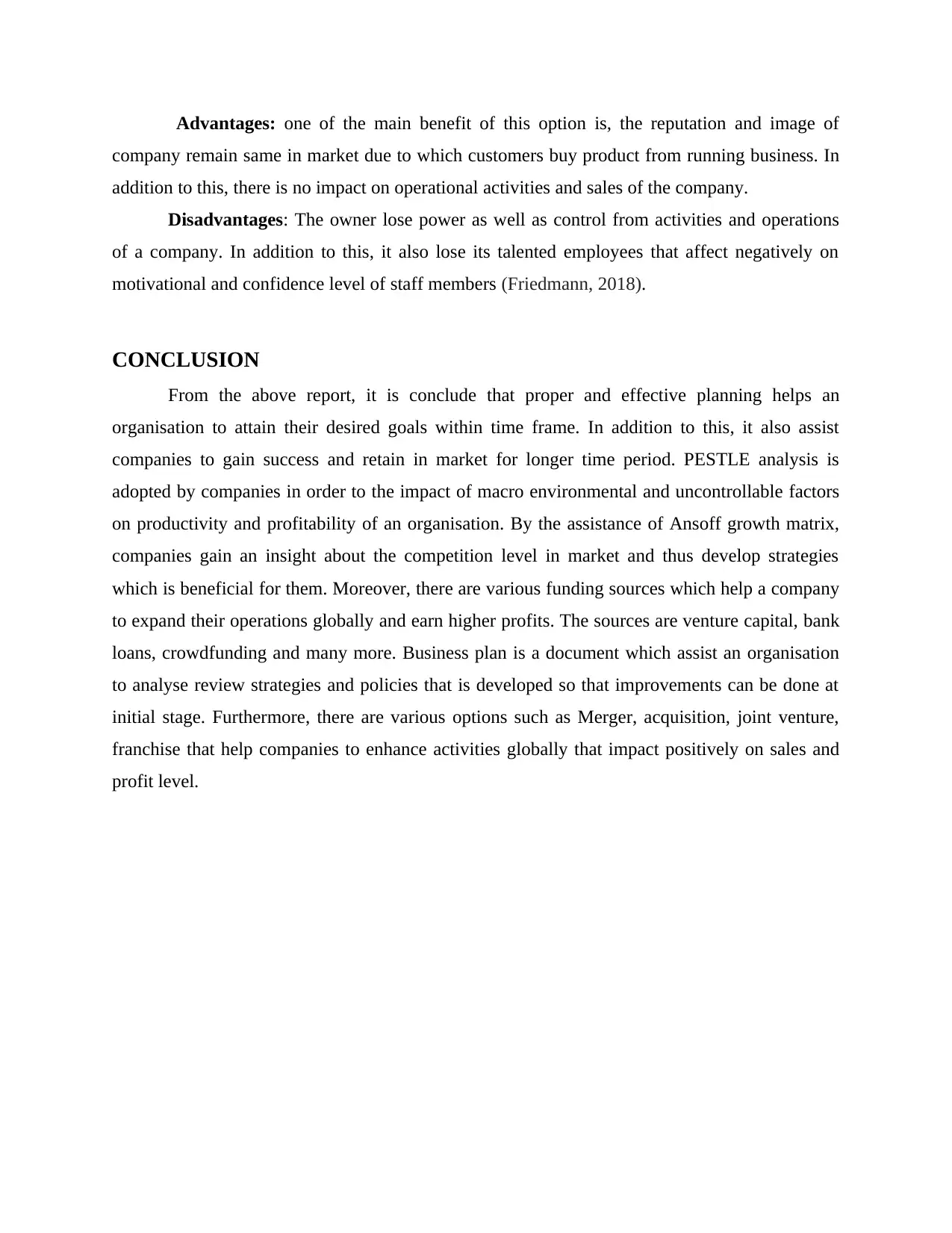
Advantages: one of the main benefit of this option is, the reputation and image of
company remain same in market due to which customers buy product from running business. In
addition to this, there is no impact on operational activities and sales of the company.
Disadvantages: The owner lose power as well as control from activities and operations
of a company. In addition to this, it also lose its talented employees that affect negatively on
motivational and confidence level of staff members (Friedmann, 2018).
CONCLUSION
From the above report, it is conclude that proper and effective planning helps an
organisation to attain their desired goals within time frame. In addition to this, it also assist
companies to gain success and retain in market for longer time period. PESTLE analysis is
adopted by companies in order to the impact of macro environmental and uncontrollable factors
on productivity and profitability of an organisation. By the assistance of Ansoff growth matrix,
companies gain an insight about the competition level in market and thus develop strategies
which is beneficial for them. Moreover, there are various funding sources which help a company
to expand their operations globally and earn higher profits. The sources are venture capital, bank
loans, crowdfunding and many more. Business plan is a document which assist an organisation
to analyse review strategies and policies that is developed so that improvements can be done at
initial stage. Furthermore, there are various options such as Merger, acquisition, joint venture,
franchise that help companies to enhance activities globally that impact positively on sales and
profit level.
company remain same in market due to which customers buy product from running business. In
addition to this, there is no impact on operational activities and sales of the company.
Disadvantages: The owner lose power as well as control from activities and operations
of a company. In addition to this, it also lose its talented employees that affect negatively on
motivational and confidence level of staff members (Friedmann, 2018).
CONCLUSION
From the above report, it is conclude that proper and effective planning helps an
organisation to attain their desired goals within time frame. In addition to this, it also assist
companies to gain success and retain in market for longer time period. PESTLE analysis is
adopted by companies in order to the impact of macro environmental and uncontrollable factors
on productivity and profitability of an organisation. By the assistance of Ansoff growth matrix,
companies gain an insight about the competition level in market and thus develop strategies
which is beneficial for them. Moreover, there are various funding sources which help a company
to expand their operations globally and earn higher profits. The sources are venture capital, bank
loans, crowdfunding and many more. Business plan is a document which assist an organisation
to analyse review strategies and policies that is developed so that improvements can be done at
initial stage. Furthermore, there are various options such as Merger, acquisition, joint venture,
franchise that help companies to enhance activities globally that impact positively on sales and
profit level.
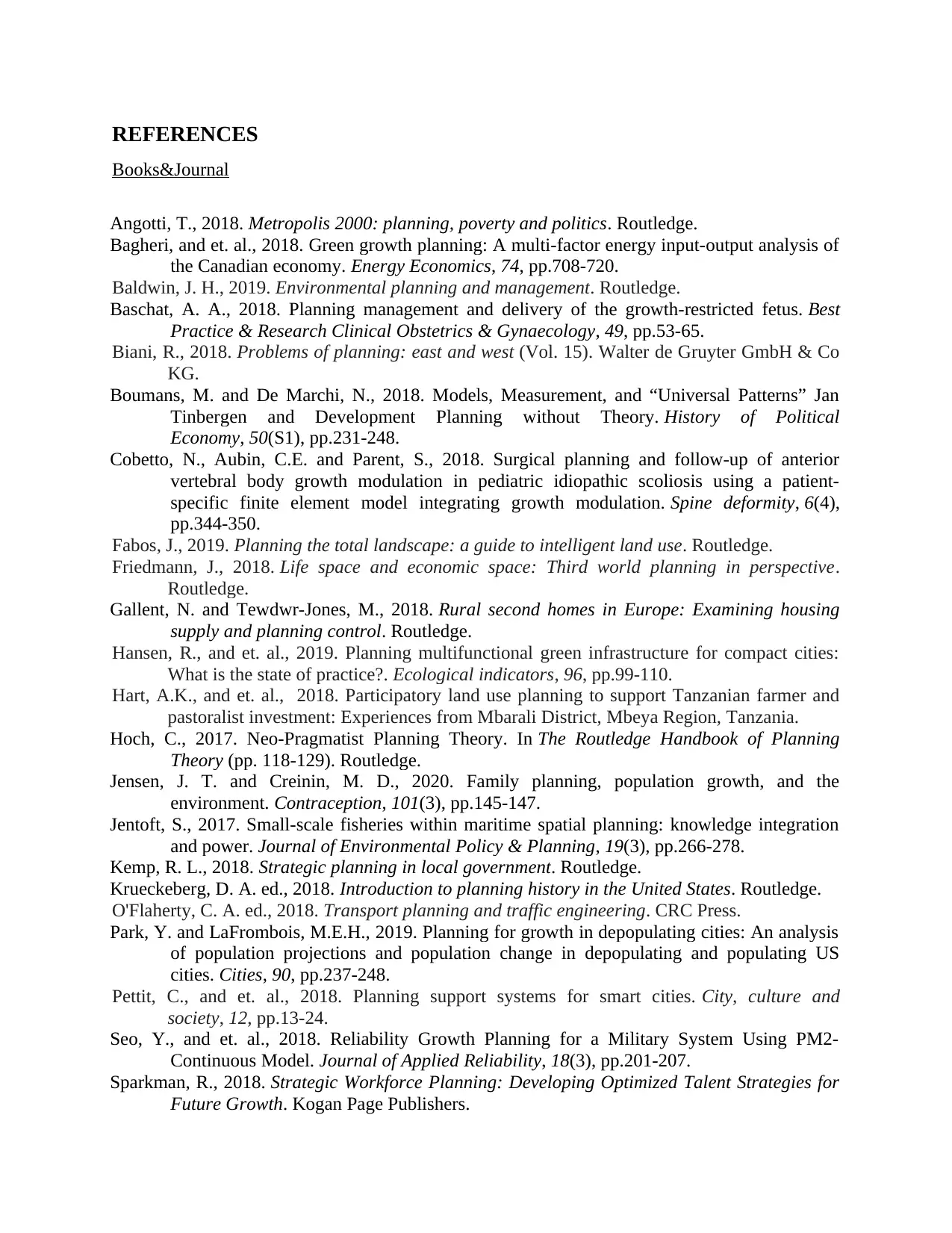
REFERENCES
Books&Journal
Angotti, T., 2018. Metropolis 2000: planning, poverty and politics. Routledge.
Bagheri, and et. al., 2018. Green growth planning: A multi-factor energy input-output analysis of
the Canadian economy. Energy Economics, 74, pp.708-720.
Baldwin, J. H., 2019. Environmental planning and management. Routledge.
Baschat, A. A., 2018. Planning management and delivery of the growth-restricted fetus. Best
Practice & Research Clinical Obstetrics & Gynaecology, 49, pp.53-65.
Biani, R., 2018. Problems of planning: east and west (Vol. 15). Walter de Gruyter GmbH & Co
KG.
Boumans, M. and De Marchi, N., 2018. Models, Measurement, and “Universal Patterns” Jan
Tinbergen and Development Planning without Theory. History of Political
Economy, 50(S1), pp.231-248.
Cobetto, N., Aubin, C.E. and Parent, S., 2018. Surgical planning and follow-up of anterior
vertebral body growth modulation in pediatric idiopathic scoliosis using a patient-
specific finite element model integrating growth modulation. Spine deformity, 6(4),
pp.344-350.
Fabos, J., 2019. Planning the total landscape: a guide to intelligent land use. Routledge.
Friedmann, J., 2018. Life space and economic space: Third world planning in perspective.
Routledge.
Gallent, N. and Tewdwr-Jones, M., 2018. Rural second homes in Europe: Examining housing
supply and planning control. Routledge.
Hansen, R., and et. al., 2019. Planning multifunctional green infrastructure for compact cities:
What is the state of practice?. Ecological indicators, 96, pp.99-110.
Hart, A.K., and et. al., 2018. Participatory land use planning to support Tanzanian farmer and
pastoralist investment: Experiences from Mbarali District, Mbeya Region, Tanzania.
Hoch, C., 2017. Neo-Pragmatist Planning Theory. In The Routledge Handbook of Planning
Theory (pp. 118-129). Routledge.
Jensen, J. T. and Creinin, M. D., 2020. Family planning, population growth, and the
environment. Contraception, 101(3), pp.145-147.
Jentoft, S., 2017. Small-scale fisheries within maritime spatial planning: knowledge integration
and power. Journal of Environmental Policy & Planning, 19(3), pp.266-278.
Kemp, R. L., 2018. Strategic planning in local government. Routledge.
Krueckeberg, D. A. ed., 2018. Introduction to planning history in the United States. Routledge.
O'Flaherty, C. A. ed., 2018. Transport planning and traffic engineering. CRC Press.
Park, Y. and LaFrombois, M.E.H., 2019. Planning for growth in depopulating cities: An analysis
of population projections and population change in depopulating and populating US
cities. Cities, 90, pp.237-248.
Pettit, C., and et. al., 2018. Planning support systems for smart cities. City, culture and
society, 12, pp.13-24.
Seo, Y., and et. al., 2018. Reliability Growth Planning for a Military System Using PM2-
Continuous Model. Journal of Applied Reliability, 18(3), pp.201-207.
Sparkman, R., 2018. Strategic Workforce Planning: Developing Optimized Talent Strategies for
Future Growth. Kogan Page Publishers.
Books&Journal
Angotti, T., 2018. Metropolis 2000: planning, poverty and politics. Routledge.
Bagheri, and et. al., 2018. Green growth planning: A multi-factor energy input-output analysis of
the Canadian economy. Energy Economics, 74, pp.708-720.
Baldwin, J. H., 2019. Environmental planning and management. Routledge.
Baschat, A. A., 2018. Planning management and delivery of the growth-restricted fetus. Best
Practice & Research Clinical Obstetrics & Gynaecology, 49, pp.53-65.
Biani, R., 2018. Problems of planning: east and west (Vol. 15). Walter de Gruyter GmbH & Co
KG.
Boumans, M. and De Marchi, N., 2018. Models, Measurement, and “Universal Patterns” Jan
Tinbergen and Development Planning without Theory. History of Political
Economy, 50(S1), pp.231-248.
Cobetto, N., Aubin, C.E. and Parent, S., 2018. Surgical planning and follow-up of anterior
vertebral body growth modulation in pediatric idiopathic scoliosis using a patient-
specific finite element model integrating growth modulation. Spine deformity, 6(4),
pp.344-350.
Fabos, J., 2019. Planning the total landscape: a guide to intelligent land use. Routledge.
Friedmann, J., 2018. Life space and economic space: Third world planning in perspective.
Routledge.
Gallent, N. and Tewdwr-Jones, M., 2018. Rural second homes in Europe: Examining housing
supply and planning control. Routledge.
Hansen, R., and et. al., 2019. Planning multifunctional green infrastructure for compact cities:
What is the state of practice?. Ecological indicators, 96, pp.99-110.
Hart, A.K., and et. al., 2018. Participatory land use planning to support Tanzanian farmer and
pastoralist investment: Experiences from Mbarali District, Mbeya Region, Tanzania.
Hoch, C., 2017. Neo-Pragmatist Planning Theory. In The Routledge Handbook of Planning
Theory (pp. 118-129). Routledge.
Jensen, J. T. and Creinin, M. D., 2020. Family planning, population growth, and the
environment. Contraception, 101(3), pp.145-147.
Jentoft, S., 2017. Small-scale fisheries within maritime spatial planning: knowledge integration
and power. Journal of Environmental Policy & Planning, 19(3), pp.266-278.
Kemp, R. L., 2018. Strategic planning in local government. Routledge.
Krueckeberg, D. A. ed., 2018. Introduction to planning history in the United States. Routledge.
O'Flaherty, C. A. ed., 2018. Transport planning and traffic engineering. CRC Press.
Park, Y. and LaFrombois, M.E.H., 2019. Planning for growth in depopulating cities: An analysis
of population projections and population change in depopulating and populating US
cities. Cities, 90, pp.237-248.
Pettit, C., and et. al., 2018. Planning support systems for smart cities. City, culture and
society, 12, pp.13-24.
Seo, Y., and et. al., 2018. Reliability Growth Planning for a Military System Using PM2-
Continuous Model. Journal of Applied Reliability, 18(3), pp.201-207.
Sparkman, R., 2018. Strategic Workforce Planning: Developing Optimized Talent Strategies for
Future Growth. Kogan Page Publishers.

Thornley, A., 2018. Urban planning under Thatcherism: the challenge of the market (Vol. 21).
Routledge.
Wang, Y., and et. al., 2019. Multi-phase reliability growth test planning for repairable products
sold with a two-dimensional warranty. Reliability Engineering & System Safety, 189,
pp.315-326.
Zhou, Y., and et. al., 2017. The effect of land use planning (2006–2020) on construction land
growth in China. Cities, 68, pp.37-47.
Routledge.
Wang, Y., and et. al., 2019. Multi-phase reliability growth test planning for repairable products
sold with a two-dimensional warranty. Reliability Engineering & System Safety, 189,
pp.315-326.
Zhou, Y., and et. al., 2017. The effect of land use planning (2006–2020) on construction land
growth in China. Cities, 68, pp.37-47.
1 out of 16
Related Documents
Your All-in-One AI-Powered Toolkit for Academic Success.
+13062052269
info@desklib.com
Available 24*7 on WhatsApp / Email
![[object Object]](/_next/static/media/star-bottom.7253800d.svg)
Unlock your academic potential
© 2024 | Zucol Services PVT LTD | All rights reserved.





